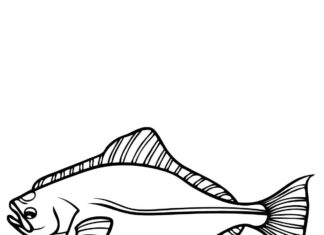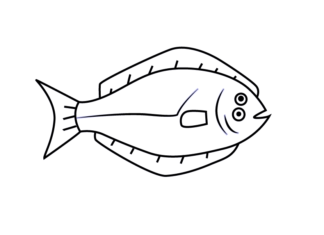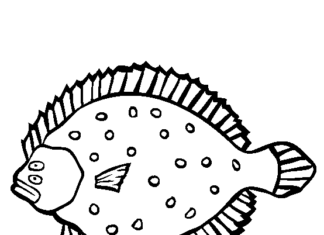Halibut is a genus of large marine fish, belonging to the flounder family (Pleuronectidae). They are fish famous for their impressive size, tasty meat and distinctive appearance.
Halibut Coloring Book
information
- Size and design: Halibuts are among the largest marine fish, reaching lengths of up to several meters and weights in excess of 300 kilograms. A characteristic feature of halibut is their asymmetrical body structure - as a fish belonging to the flounder family, they lie on the seabed with one side colored (top) and the other side (belly) similar in color to their surroundings.
- Habitat: Halibuts live in deep ocean waters, usually on the seabed, although they sometimes float slightly above the bottom. They inhabit cold and temperate waters, found along the coasts of northern Europe, North America and Asia.
- Food: Halibuts are predators that hunt a variety of marine organisms such as fish, crustaceans and squid. Their hunting strategy is to camouflage themselves on the seafloor and then violently attack their prey.
- Economic Significance: Halibuts are commercially important in the fishing industry because of their tasty white meat. They are popular in the kitchen as a tasty and delicate dish.
- Fishing and a sustainable market: Due to their large size and growing demand, many halibut fish are now farmed to protect wild fish populations and maintain sustainable fish. They are usually caught using fishing rods or nets.
- A mix of flavors: Halibut meat is considered tasty, with a delicate texture and a subtle, slightly nutty flavor. As a result, it is prized by chefs and restaurants around the world.
- Preparation: Halibut is versatile in terms of preparation and can be boiled, fried, grilled, roasted or steamed. Due to its low fat content, it takes well to a variety of additives and seasonings.
- Species: There are several species of halibut, the most famous of which are Atlantic halibut (Hippoglossus hippoglossus) and Pacific halibut (Hippoglossus stenolepis). Both species are prized for their tasty meat.
trivia
- Size records: Halibut, especially Pacific halibut, reach enormous sizes. A record example is the Pacific halibut caught in 2014, which weighed as much as 232 kilograms.
- Variable color: Halibuts are born with a symmetrical appearance, but during development one eye shifts to the other side of the body, making one side darker and better suited for camouflage on the seafloor.
- Adapting to life at the bottom: Because halibut live on the seafloor, their eyes are adapted to seeing in low-light conditions. An upward-facing eye allows them to observe prey and potential threats above them.
- Long life: Halibuts can reach an age of even more than 50 years, which is impressive compared to other fish species.
- Stomach stones: Halibut, like other fish, have stomach stones that help them digest their food. Sometimes these stones are used by humans as gadgets and talismans.
- Relevance to fisheries: Due to the popularity of halibut as a source of tasty meat, many regions are conducting fisheries management to protect populations and maintain a sustainable fishery.
- Seasonal migration: In winter, halibut usually move to deeper waters, and in spring and summer they return to shallower areas to feed and breed.
- Valued in the kitchen: Halibut meat is prized in the kitchen for its tenderness and ability to be cooked in a variety of ways. It is a popular ingredient in many fish dishes in restaurants around the world.
- Traditions of culinary use: In local cuisines in areas where halibut are found, such as Alaska and Scandinavia, the fish plays an important role in culinary culture.
- Halibut as sport fish: Because of their impressive size and strength, halibut are prized in sport fishing. Anglers appreciate the challenge and excitement of catching these fish.







